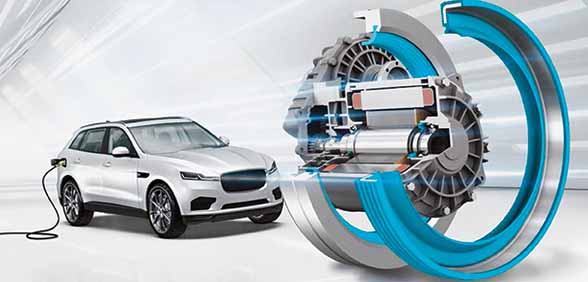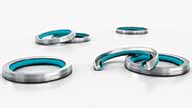ACI Bureau
Trelleborg Sealing Solutions, a leading developer, manufacturer and supplier of precision seals, bearings and custom-moulded polymer components, has launched HiSpin PDR RT and HiSpin HS40, 2 seals specifically developed for electric vehicles. Engineered to operate at high velocity, they help overcome issues related to sealing at high rotary speeds that limit electric cars being able to meet the ultimate goal of travelling the same distance as a gasoline vehicle on one charge.
According to a report by the International Energy Agency (IEA), there were 3.1 million electric vehicles on the roads globally in 2017. This is expected to grow exponentially to at least 125 million and potentially 220 million, by 2030. This depends on the existence of a viable technology that allows travel from 1 charge that is equivalent to a tank of gasoline, giving car drivers the independence they are used to from the conventional vehicles. These 2 new seals will help make this possible.
Jan Zumbach, the Head of Business Development for e-Mobility, Trelleborg Sealing Solutions, said that overcoming ‘range anxiety’ is critical to mass adoption of electric vehicles. With gasoline or diesel vehicles people know they will get where they want to get to. The infrastructure is there and filling up the tank is never an issue. When people drive an electric vehicle they worry if they will have enough charge to arrive at their chosen destination, and a lack of charging points and the time taken to charge a battery, make them nervous. The solution to this is to install a charging infrastructure and increase battery capacity to extend the distance that can be travelled on 1 charge.
“A limiting factor in achieving this is the seal in the e-axle. The new HiSpin PDR RT and HiSpin HS40 will contribute to extending the travelling distance of electric cars, helping make the mass adoption of these vehicles a reality, rather than a dream,” he said.
A major technology in electric vehicles is the e-axle, a combined electric motor and gearbox that fits within the traditional engine space. The motor and gearbox are directly coupled but while the gearbox requires efficient lubrication, it is essential that the motor remains dry and so a highly reliable seal is required between these 2 components.
Paul Taylor, Product Line Director at Trelleborg Sealing Solutions, said, “As electric motors run most efficiently at high speeds, the seal requirements are very different from those for a transmission input on a combustion-engine vehicle. Gasoline engines normally run at 2,000 to 4,000 RPM but the electrically driven transmission runs up to 8 times faster typically at 16,000 RPM and in the future this is likely to increase significantly.”
The rotational surface speed limit for traditional seals in the e-axle of today’s electric cars is around 30 meters per second. The theoretical optimum rotational surface speed of the e-axle would be greater than 60 meters per second to maximise efficiency, a speed that is currently impossible to achieve.
“Our aim for the new e-Mobility seals was to increase operating rotational speed to at least 40 meters per second. We achieved this for HiSpin HS40 and an outstanding 60 meters per second with HiSpin PDR RT,” he said.
Another issue that had to be overcome is the lack of lubrication in the system. In the gearbox of the electric drive system, lubrication can be very limited; there is usually just a mist of lubricant. When there is little or no lubrication, sealing is more challenging. In these conditions rotating seals will be subject to high frictional forces and stick-slip after periods of rest, potentially causing wear and shortening the life of a seal, as well as power loss, lowering the travelling range of the vehicle.
Diversity of lubricants in the electric drive system is also difficult and not all sealing materials are compatible with or operate effectively in the media involved. In addition, the trends in lubricants used could bring up unknown challenges when water-based, dielectric and lower viscosity media come into play.
To ensure that the needs of electric car manufacturers could be met quickly, Trelleborg Sealing Solutions put together a rapid response team to develop new e-Mobility seals.
Colin Macqueen, who headed the seal development programme, said, “Traditionally product development can be a slow process. But when supporting manufacturers to make electric vehicles travel further became a priority, an agile team of experts were asked to come up with a solution rapidly that could stand up to the high rotational speeds involved in e-Mobility applications, as well as lack of and variations in lubrication. Development took just 8 months from convening of the project team to initial availability of the seals to customers.”
The result of the rapid development programme was 2 solutions that are being launched together as HiSpin PDR RT and HiSpin HS40. They both have the same function but dependent on the operating parameters of the electric drive system and the customers’ preferences, one is likely to suit a system better than the other.
Matthias Keck, Director Technology and Innovation, Trelleborg Sealing Solutions in Germany, said, “Testing was extremely positive. There was zero leakage for both seals despite the very demanding sealing conditions. HiSpin PDR RT recorded 75% reduction in friction versus a standard PDR seal and proved to be capable of operating at 60 meters per second.”
HiSpin PDR RT is constructed from 2 parts: a precision manufactured metal body and a mechanically retained Turcon polytetrafluoroethylene (PTFE) sealing element. It has a custom designed lip with additional features that improve performance and behavior of lip lay down profile on shaft, crimped into a precision-machined body.
Capable of speeds of 60 meters per second and beyond, it has both high and low temperature capability. Able to handle pressure, it is universally compatible with chemicals and its low friction coefficient means it is capable of dry running. Prototypes are offered through a recently launched Rapid Prototype Service introduced to support customers. A conductive PTFE based grade is available.
HiSpin HS40 is of a familiar product type to automotive customers. With a unique bi-directional hydrodynamic lip feature it has negligible frictional torque at high speeds. As a result of extensive FEA studies, its rubber lip geometry and flexible design give optimum lip contact on the shaft, ensuring optimum static and dynamic sealing performance.
The seal is manufactured using proven proprietary XLT Fluoroelastomer (FKM) compounds to meet higher speeds and a wider operating temperature range. Compatible with increasingly aggressive synthetic Automatic Transmission Fluids (ATF), it is produced using proven conventional high volume manufacturing processes.Capable of speeds up to 40 meters per second, the HiSpin HS40 has the ability to handle run-out and is easy to install. ACI










Leave a Reply